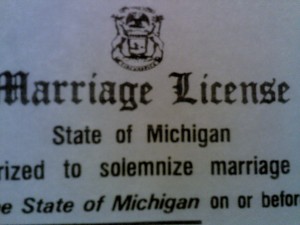When the financial collapse happened in 2007, this not only affected the house and banking industry, it affected everyone; this including the wedding industry. What was once a grand idea of a big fabulous wedding turned into being budget conscious and scaling back on one of the biggest decisions of ones life. Marriages statistics as a whole show an up and down scale.
Back in May, International Business Times stated this, According to Fox News; the percent of married households in the United States fell to 48.4 percent in 2010, down from 55.2 percent in 1990 and 78 percent in 1960. This is the lowest in recorded history for our country. In 1960, according to the LA Times, almost 50 percent of the 18-24 year olds and 82 percent of 25-34 year olds were married. Today, it is 9 percent of the 18-24 group and 44 percent of the 25-34 group.
According to cnsnews.com it stated, “The 48 percent of husband-and-wife households in 2010 was the first time since at least 1940 that this has fallen below 50 percent,” said Daphne Lofquist, Statistician for the Fertility and Family Statistics Branch for the Census Bureau.
With these statistics is shows that more and more people are not getting married. Well marriage according to male and female relationships. During the 2010 census some information had to be re-released regarding same-sex household, indicating the total number of same-sex unmarried partner households to be 0.6 percent — 646,464 out of the total 116,716,292 households. Furthermore Lofquist had this to say, “Identifying as a same-sex couple may be more acceptable now than it was in 2000, so that the group who identified themselves as same-sex couples might be a somewhat different group than it was in 2000,” she said.
The Huffington Post reported that University of Virginia researchers found when people get married and have children, several sectors of the economy experience growth. They include childcare, life and personal insurance, household products and services, health care, food, home maintenance and home services, pets and toys. A strong economy depends on a strong family unit because they not only provide the current customer base, but also provide the future workers in an economy. With marriage and fertility rates slowing, this trend of fewer marriages will have a negative long-term impact on the economy.
Katherine Delpra owner of Bride Appeal had this to say about her clients who are wedding planners, “their business is definitely up in 2013… None the less, they are seeing slightly smaller weddings, but a higher quality and volume of clients.”
With all the research age plays a big factor on when one decides to get married. Today, the average age of a first marriage is almost 27 for women and 29 for men, up from 20 and 22 in 1960. It also looks like 15 percent of the population today will remain unmarried compared with the historic norm in the U.S. of 10 percent, as its stated in the International Business Times article.
Kristopher Thomas, a married man of seven years had this to say about the changing winds of marriage; “A strong society starts with a strong family, the foundation of a strong family is a strong marriage”.
Marriage may have declined but as statistics show in order for the economy to grow people need to get married. One could think of it as a “Circle of Life” once nicely stated in the Well-Acclaimed Disney movie “Lion King”. In order to keep order, there needs to be constant flow of checks and balances.

Photo Taken By: Constance Thomas, Personal License.

I love the helpful tips people give in your posts. I will bookmark your current blog page in addition to take a look at just as before right here frequently. I am somewhat specific We are informed loads of new products below! Good luck for the next!